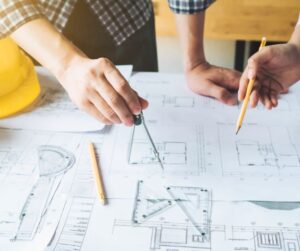 Since its creation under the Energy Policy Act (EPAct) of 2005, the §179D deduction has enabled countless building owners and designers to reduce their tax burdens while incentivizing the installation of energy-saving measures in buildings across the U.S. The deduction has been modified several times over the years, and was most recently expanded by the Inflation Reduction Act (IRA) of 2022. In addition to raising the maximum deduction amount from $1.80 to $5.00 per square foot (plus the annual inflation rate adjustment), one of the most notable changes under the IRA was the creation of an alternative deduction path for retrofits to older buildings.
Since its creation under the Energy Policy Act (EPAct) of 2005, the §179D deduction has enabled countless building owners and designers to reduce their tax burdens while incentivizing the installation of energy-saving measures in buildings across the U.S. The deduction has been modified several times over the years, and was most recently expanded by the Inflation Reduction Act (IRA) of 2022. In addition to raising the maximum deduction amount from $1.80 to $5.00 per square foot (plus the annual inflation rate adjustment), one of the most notable changes under the IRA was the creation of an alternative deduction path for retrofits to older buildings.
Changes to the §179D Deduction under the Inflation Reduction Act
Projects placed into service on or after January 1, 2023 are eligible for the new deduction amount of up to $5.00 per square foot for energy-efficient improvements to the building’s interior lighting systems, HVAC and hot water systems, and the building envelope. However, the specific deduction amount is based on a sliding scale:
- Projects that achieve a minimum of 25% energy cost savings compared to the applicable ASHRAE Standard but do NOT comply with local prevailing wage and apprenticeship requirements for workers associated with the project will qualify for a deduction of at least $0.50 per square foot. Each 1% of additional savings above 25%, up to 50%, will yield an additional deduction of $0.02, up to $1.00 per square foot. While the wage requirement is a new addition to §179D, the requirement of achieving at least 25% energy cost savings compared to the applicable ASHRAE Standard is a notable decrease from the previous requirement of 50% cost savings. This represents a new opportunity for many existing buildings with energy-efficient retrofits to qualify for the §179D deduction, as older buildings are often unable to meet the 50% energy savings threshold.
- Projects that achieve a minimum of 25% energy cost savings and do meet the local prevailing wage and apprenticeship requirements will be eligible for a minimum deduction of $2.50 per square foot; each 1% of additional savings will yield a $0.10 per square foot deduction, up to the maximum amount of $5.00.
Other changes to the §179D deduction under the IRA include:
- Real estate investment trusts (REITs) may now claim the deduction.
- In addition to government entities, nonprofit organizations, tribal entities, religious institutions, and not-for-profit schools and universities may now allocate their §179D deductions to primary designers, such as architects, engineers, and contractors.
- For projects placed into service prior to 2023, the applicable ASHRAE Standard was whichever one was in effect two years before construction began. The IRA changed this to whichever ASHRAE Standard was in effect four years before the completion of construction.
- Commercial buildings may now be re-certified for the deduction every three years, and projects for buildings owned by the government and other not-for-profit entities may be re-certified every four years. Prior to the IRA, the §179D deduction could only be claimed once over the lifetime of a building.
Sect. 179D(f) Alternative Deduction Path
In addition to the lower threshold of 25% energy cost savings, there is now another opportunity for the owners of existing buildings to reduce their tax burdens by installing energy efficiency measures. Section 179D(f) has added an alternative deduction under which energy savings are assessed by the level of energy usage, rather than the amount of energy costs. Gains in energy efficiency are determined by comparing the building’s specific level of energy usage intensity (EUI) before the retrofit to the EUI after the retrofit, thereby generating a percentage reduction in annual energy usage. This method of referring to the building’s own energy usage as a baseline is more advantageous for older buildings, which may be unable to meet the “one-size-fits-all” ASHRAE Standard 90.1 required to qualify for the §179D deduction.
In determining the specific deduction amount under this alternative method, the same sliding scale described above is used. The deduction amount is limited to the cost of the energy efficiency measures placed into service. The alternative §179D deduction is not taken when the property is placed into service, but rather one year later after a “final certification” has been completed to confirm the percentage reduction in annual energy usage.
Taxpayers seeking to claim the alternative §179D deduction must provide a “qualified retrofit plan” describing the specific modifications that are expected to reduce the building’s EUI by at least 25%. While the plan does not need to be reviewed or approved by a governmental agency, it must be certified by a professional, such as an architect or engineer. At Capital Review Group, we are monitoring the latest developments on the §179D(f) deduction, as we anticipate that the IRS will provide additional guidance on how retrofit/renovation projects must be certified and how the amount of energy savings should be calculated.
For taxpayers seeking to maximize savings through the standard §179D deduction or the alternative path, the key is to work with a qualified certification firm such as Capital Review Group. With a unique combination of tax and engineering expertise, our team has helped numerous clients receive substantial tax savings through this deduction alone. Contact us today to schedule a consultation or to learn more about the newest changes to the §179D deduction!
(Sources: https://www.thetaxadviser.com/issues/2023/feb/recent-changes-to-the-sec-179d-energy-efficient-commercial-buildings-deduction.html, https://uscode.house.gov/view.xhtml?req=(title:26%20section:179D%20edition:prelim)